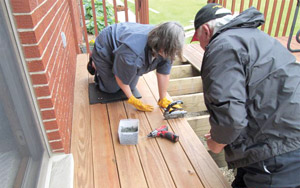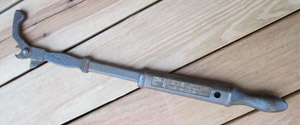Over the years, I’ve written about a lot of water wells and groundwater subjects, drilling methods, various types of pumps, pipe and other topics. On occasion, I have digressed and written about pickup trucks and soft drinks and other things that aren’t really about water wells. Recently, I have been writing about well screens and will get back to that subject in future columns, but this one is about something totally different.

|
|
Linda and John Schmitt put in work on the family’s deck. Even drillers need to dedicate time to honey-dos, right? Source: John Schmitt |
My wife, Shirley, and I live in a rather modest three-bedroom brick ranch house. It has a full basement and what probably would be called an attached 21⁄2 car garage. We moved into this house brand new on April 15 (tax day), 1991.
I served as my own general contractor in the construction of our home and did all the pressure piping, wiring and some of the drains, in addition to the well and pump system. I did not do any carpentry, masonry, dry-walling or sheet metal. On the back side of our house, right off the dining area, our carpentry contractor constructed a 16-by-12-foot wooden deck. This can be accessed through a French door through the dining area or up a step from the sidewalk that runs along the back of the house. This deck was installed a few days after we moved in. The deck was constructed of cedar boards, the so called 5⁄4 thickness—these being a full 1-inch thick. They were plain cedar and, of course, we treated them with stain. Over the years, we re-stained them many times but never pressure washed them which is, I understand, what you are supposed to do before re-staining. They held up quite well, but by this spring they were 22 years old.
After the snow melted this spring, our deck looked a little worse for wear. Worse yet, we had three boards that looked like they might be ready to give way and, of course, the worst of these was right smack where one would step coming up the steps from the sidewalk. Shirley and I discussed our options and decided perhaps we should re-do the whole darn thing, at least the deck boards, as the joists and anchor posts are all of treated material and look to be in good shape.
I contacted a local lumber yard and found that in 2013 there is a wide assortment of deck boards available. The list begins with cedar, just like we had in 1991, treated boards, which in my opinion have a tendency to warp, and a new trademarked material called “Prowood,” which is stained clear through and supposedly needs not be stained for two to five years. The top of the line material is a composite plastic and these sound great ’til one learns that a single 16-foot long board costs $62. Needing about 26 boards to do this job, I quickly lost my appetite for composite. The other three materials are closely priced from about $9 to $13 per board. After consideration, we decided to go with the Prowood, which the lumber yard delivered the next day on a nice, sunny morning.
Well, now we have the new material but we’ve got to get the old off. And who do we have for workers? Well, we’ve got your author, his wife of over 54 years, Shirley, and their oldest daughter, Linda, who is in her early 50s. Now, Shirley is a former farm girl who can drive most any vehicle including two-ton trucks and tractors, but she does not really like this since she studied after high school to be a secretary not a mechanic. Shirley, in fact, worked for quite a few years as the office manager of a large book manufacturing company and was of untold help to me in my years as executive director of the Michigan Ground Water Association. As much as I love her, and she has been a wonderful wife and mother, she is not a mechanic.
Now, daughter Linda is a little different; she has a business degree from Michigan State University and works part time for a building management association and also is a substitute elementary teacher. While she is like her mother in that she is a good and loving wife and mother, she is also a pretty good mechanic. I don’t know if she learned this from me or picked it up herself, but she can hold her own with tools.
Anyway, armed with this work crew, we went at the re-deck project. We quickly found that the hardest part was removing the old boards. We started with a nail pulling device that has a couple of “pinchers” that go down over the head of a nail and are driven into the wood with a sliding hammer. My dad bought this tool many years ago and the sliding hammer will pinch one’s fingers something fierce if you are not careful. Once the “pinchers” are driven into the wood it can be used like crow bar and pulls the nail out. Daughter Linda was particularly adept at using this confounded thing and managed to pull a number of boards without pinching herself.
After we got a couple boards free, we removed the others by an easier method: placing a 2-by-4 across two joists and then inserting a 6-foot pipe under the offending board and using a 2-by-4 as a fulcrum. I would step on the pipe and with a rather loud noise the board would come off, usually pulling the nails holding it down with it, and those that did not come out, we pulled with a crow bar. Some boards splintered into many pieces, making a real mess.

|
| A nail puller helped get the project started. Source: John Schmitt |
We then began installing the new boards and they were screwed down using a handy jig, or I guess you could call it an alignment tool. This went down over the edge of the boards and had two holes to guide the screws. The provided screwdriver bit has a shoulder on it so the screws can’t be overdriven and, as they go in the edge of the board on an angle, when done you can hardly see the screws at all. Oh yes, this jig has tabs that are used to separate the individual boards evenly. Of course, the jig cost about $65 and the screws were pretty expensive, but I would have to say they are worth it.
After we started installing the new boards, we got into a pretty good routine—the ladies would select the appropriate board, I would saw it off as they were a little too long for our needs, and my daughter and I would screw them down. The deck looks really good, a huge improvement over the old weathered cedar boards, and should last the lifetimes of my wife and I. We had one little accident where my daughter stepped on my famous 2-by-4 fulcrum, it went out from under her and she fell through with a leg on each side of a joist. Fortunately, it is only about two feet to the ground and she only bruised her thighs and a wrist, but no blood was shed. Her mother viewing this had a near fit as her darling daughter got injured.
Well there you have it: what it is like to work with female help or no “man” power. I have to admit that my ladies did very well and this should not have been a surprise, as both of them have been out on an occasional well job and served as quite competent helpers. Shirley and I changed out a large pressure tank for a longtime customer and, as we struggled to skid the old tank up his basement steps, we reminded him that we were in effect “grandpa and grandma’s well service—we get the job done, it just takes a little longer.”
The weather in Michigan has ranged from very hot and extremely humid to rather cool, and we have had a lot of rain in the first few days of summer. Our farmer friends have not needed to use their brand new center pivot systems and their new irrigation wells. Next time, we will get back to well screens and more subjects that really are water well related.




Report Abusive Comment